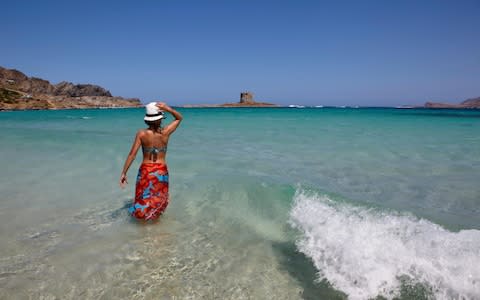Celebrated beach in Sardinia to put cap on number of visitors and charge for entry
One of Italy’s most photogenic beaches is to start charging entry and will put a cap on visitor numbers, in what is believed to be the first case of its kind.
The white sands and turquoise waters of La Pelosa beach in Sardinia make it hugely popular but local authorities are concerned about the impact of so many visitors.
Starting next summer, tourists will have to pay an entrance fee and the number of beachgoers will be capped at around 1,500 a day.
Once capacity is reached, holidaymakers will have to take their beach towels and bottles of Ambre Solaire elsewhere.
Described as “one of the most beautiful beaches in Europe” by travel websites, La Pelosa looks out onto the tiny island of Asinara, a former penal colony which is famous for its population of rare white donkeys.
The move was announced by Antonio Diana, the mayor of the local town of Stintino.

The restrictions are part of a study by ecologists from the nearby University of Sassari on the impact of visitors on the beach’s ecosystem.
“It’s an experiment in which people will have to buy an entrance ticket – the money will be used to fund the maintenance and monitoring of the beach,” said Mr Diana. “The cap will be set at around 1,500 people.”
Sardinians have long claimed that their beaches take a hammering from tourists.
Each year, visitors are caught trying to steal bags of sand and shells from beaches around the island, with some saying they wanted a souvenir and others hoping to use the material for home aquariums.
This is thought to be the first time, however, that visitor numbers will be capped with a ticketing system.

It is not just Sardinia’s beaches that are feeling the strain. Venice is to introduce a tax on tourists from July 1, although the city is calling it “a contribution for access” to the World Heritage site.
The aim of the controversial tax is to make day-trippers contribute to its upkeep.
Tourists will pay €3 each during the low season, €8 during high season and €10 during “critical” periods when visitor numbers reach excessive levels.
Last year, a picturesque clifftop village in the south of Italy caused controversy by charging visitors to enter its historic centre.
Tourists were required to pay €5 (£4.40) to enter the cobbled heart of Polignano a Mare, a spectacularly-sited village of whitewashed houses and churches perched on top of cliffs in the southern region of Puglia.
The ticketing system started in November and continued through Christmas season until Epiphany on January 6, a period in which the village is illuminated by thousands of festive lights.
An entry fee is also charged for Civita di Bagnoregio, a tiny hamlet that perches on an outcrop of tufa rock north of Rome.
A perfectly-preserved medieval village, it is accessible only by a long pedestrian bridge that spans a deep canyon.
The village has a permanent population of less than 10 but draws hundreds of thousands of visitors a year.

 Yahoo News
Yahoo News 
